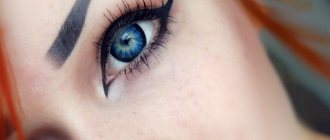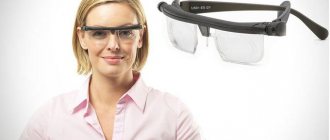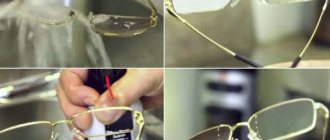Why is interpupillary distance measured?
Genetics plays an important role in the development of eye length. In an adult, the anterior-posterior axis is no more than 24 mm. But there are exceptions when this mark rises to 27 mm. This is affected by a person's height. Final growth ceases with the active development of the human body.
If the eyes constantly get used to the stress of insufficient lighting, then myopia begins to develop. Then the PZO indicators will be pathological. The risk of developing myopia is the same in children and adults. Failure to protect your vision significantly increases the risk of developing myopia.
It is imperative to monitor PZO indicators if there is a suspicion of refractive error in children and adolescents. This method is currently the only one for diagnosing and monitoring the progression of myopia. As the child ages, the length of the eye reaches normal levels.
For each person, length indicators may differ from the norm. In this case, the development of pathological changes or diseases is not observed. Each person's body is individual. Interestingly, eyeball length may have a genetic inheritance. The final size measurement can be taken when a person's growth stops.
Children's glasses lenses
Due to active play and sports, children are at greater risk of eye injury than adults. To ensure that the glasses themselves do not cause injury, they must be made of impact-resistant materials. Children's glasses should have plastic rather than glass lenses. polycarbonate and Trivex have the greatest resistance to impact loads - they are lightweight, durable and represent the optimal combination of comfort and safety. In addition, lenses made from these materials protect the eyes from UV radiation. Some opticians work only with polycarbonate when selecting children's glasses, others prefer Trivex, especially if the refraction does not exceed 3.00 diopters. Many manufacturers produce lenses for children from these materials with the most scratch-resistant optical coatings, because many young clients do not always handle glasses carefully. It should be understood that the higher the quality of the optical coating, the more expensive the lenses will be. In addition to preventing injury from chipped lenses and broken frames, children should also be protected from: - ultraviolet radiation; — excessive exposure to solar radiation (“ Risk of excessive exposure to solar radiation ”); — interfering glare of reflected light*; - exposure to blue light emitted by artificial lighting sources - energy-saving compact fluorescent lamps, which are often equipped in classrooms, and LCD screens of electronic devices. _______________ * For this purpose, lenses with anti-reflective coating are recommended for children.
Brands of children's glasses:
Optical stores in your region where you can buy children's glasses and online stores that deliver to your region
Other related articles:
How to preserve your child's vision?
Contact lenses for children
Normal values
Each person has individual visual field and viewing angle indicators. This may be influenced by the following factors:
- structural features of the visual organs
- shape and size of eyelids;
- individual characteristics of the eye orbits.
The viewing angle also depends on the size and distance of the object from the eyes. It is worth noting that the structure of the visual apparatus may depend on the characteristics of the skull. These indicators are laid down by nature. Limitation of vision depends on the structure of the brow ridges and nose. For each person, such indicators are individual and depend on the anatomical structure. Interestingly, they can change with age.
If your latest prescription does not indicate the PD value, you can use the old one, since in adults this parameter does not change over time. However, using the old recipe for children is not permissible.
Big eyes
Physiognomy tends to consider large eyes as a sign of breadth of perception. Their owner has many interests, is curious and is drawn to everything new. His range of hobbies is quite wide, and his list of contacts is huge. On the other hand, a big-eyed person is quite emotional and often vulnerable. This makes him unstable and capable of abrupt, sometimes rash actions and other manifestations of ardor and impulsiveness. The artistry and energy of his figure attracts people to him, and he is often the center of attention. In addition, he is not deprived of leadership abilities.
But, for example, physiognomy attributes deep-set eyes to people who are not passionate about public affairs. In any situation, they take, first of all, the position of an observer and analyze events and people without interfering. Of course, such people may also have large eyes, and this leaves its mark on the personality. Therefore, in each case it is worthwhile to carefully approach the interpretation of the image.
Self-measurement of pupillary distance
You can measure the distance yourself, but doctors do not recommend doing this. Data may be incorrect. You can get reliable results only after consulting an ophthalmologist. He uses special equipment that allows him to obtain reliable results. After this, a prescription for purchasing glasses or other optical products is determined. But if you need to get PD data, then you can do it in a simple way. To do this you will need the help of a loved one and a millimeter ruler.
The person should hold it between their thumb and index finger, with their free fingers facing your face. Then you should close your right eye and look at the other person's left eye. It should align the zero mark with the edge of the iris of your right eye. Then such manipulations are carried out with the left eye.
Wide-set eyes - correction with makeup
If the distance between your eyes is greater than the length of one eye, then your eyes are wide apart. You need to bring them a little closer together.
Distribute the shadows according to the principle medium (2) - light (1) - dark (3). This way, the light highlight that attracts maximum attention will be in the center of the eyelid, and the eyes will appear a little closer.
It is important to darken the eye along the contour right up to the inner corner. It is advisable to do all the darkening with this shape within the outer corner of the eyes and not shade the shadows towards the temples. On the contrary, stretch the dark shadows from the outer corner to the crease of the upper eyelid and then along the inner corner.
When coloring your eyelashes, arrange them with the sun and paint evenly from the first to the last lash.
To enhance the effect, pull your eyebrows closer to each other, adding additional hairs at their base.
Check with an ophthalmologist
You can measure the distance between the pupils yourself. But in order to get a reliable result, it is recommended to contact an ophthalmologist. Using a special ruler, the doctor can determine the choice for patients with farsightedness or myopia. The ruler is placed at different distances for each pathology.
The pupillometer method is used to determine not only the distance between the pupils, but also their diameter. It can only be used by ophthalmologists. A modern special device has different settings that guarantee the accuracy of the result.
Main advantages:
- a fast and accurate way to get reliable results;
- the influence of light and uncontrolled movements of the pupils have no effect on the result;
- the doctor receives the data on a special device.
This device allows you to get accurate results in a short time. The modern method is used for strabismus, asymmetry, farsightedness, and myopia. Despite these advantages, there are also certain contraindications:
- crooked nose bridge (very common);
- severe visual impairment;
- osteochondrosis of the cervical spine.
If there are contraindications, this method is not used. Therefore, doctors use a simple ruler, which also allows them to obtain reliable results.
Author's rating
Author of the article
Alexandrova O.M.
Articles written
2031
about the author
Was the article helpful?
Rate the material on a five-point scale!
( 1 ratings, average: 1.00 out of 5)
If you have any questions or want to share your opinion or experience, write a comment below.
“We need a performer who writes lyrics and bakes cupcakes between intermissions.”
Every artist who has made at least one attempt to plunge into the swamp of Sovriska and play by its meaningless rules has heard about the brave video “Take Your Hands Off the Vagina of Culture.” The St. Petersburg cooperative “Techno-Poetry” presents the premiere of a new music video: at Kolta’s request, the cooperative members added several original comments.
Techno-Poetry — “We hope you will apply again” Lyrics, vocal, choreography: Marina Shamova Music, mastering: Anton Komandirov Costume designers: Ruslan Rychagov, Sergey Illarionov Director, editing: Anastasia Vepreva Camera: Andrey Nesteruk Cast: Roman Osminkin, Marina Shamova, Anton Komandirov, Anastasia Vepreva Big thanks to performative arts studio SDVIG St. Petersburg. 2019
Marina Shamova
From time to time, somewhere on Facebook I see invitations to participate in the cool work of a cool European choreographer/dancer whose name is written in capital letters. The capital letters say: this name and participation in his/her production is what you dream of, namely, to gain a little more experience before you can charge for your work as a dancer/performer.
Even if you are a student and your participation is an educational project, this also makes it very difficult to pose the question: in Russia there is no profession of “performer” or “dance artist,” but there are requirements for “professional skills.” They require a certain professional level of training, the presence of interdisciplinary, technical, somatic, performance skills, etc. These requirements can be considered not only at the level of private advertisements from modern dance gurus from Europe, but also in the situation of contemporary art in general. If you are a dance artist and want to take part in some wonderful festival, where participation itself is, of course, a fundamental opportunity for your resume and future “career”, you will have to understand that the money for the project is money for materials, an account for the purchase of which - a check. And if you work as a performer/dance artist, without producing an object that will work in space without your presence (body), you will not receive money for the implementation of the project.
At the same time, all you need to implement the project are your performance, technical, somatic and other skills, which, by a lucky chance, you received by recently taking part in the project of a choreographer from Europe, who came to implement it in Russia under the terms of a European grant. And your work was paid little or not at all, because the grant application did not include payment for the work of invited dancers.
In general, stop engaging in self-exploitation and agreeing to working conditions that are uncomfortable for us. Or maybe it’s time to understand what “comfortable working conditions” means? We shouldn't have to work another job that makes us money so we can do our art or dance for free. Yes, there are different situations and alternative communities that we ourselves create, but if we are dealing with institutions and art markets, then fuck off. Enough! “Impostor syndrome” is a side effect of neoliberalism.
From the project “History of Fails”© Anastasia Vepreva
Roman Sergeevich
It’s probably worth first contextualizing this video and grounding it in our material (aka production) conditions. In general, our cooperative “Techno-Poetry” in its current composition - musician Anton Komandirov, dance artist and choreographer Marina Shamova, artist Anastasia Vepreva and me, poet Roman Osminkin - was formed recently: just last year we released our first album “Vagina of Culture”, where most of the compositions are artistic statements on topics such as social and gender inequality, precarity of the creative worker, non-normative body, anti-fascism, anti-sexism, queer aesthetics. But if our first video for the title track of the album was a direct manifestation of our political and cultural position, a literal demand to “take your hands off the vagina of culture” in every sense, then this particular video, through a subversive affirmation, produces a gesture of institutional criticism of the modern art industry. The text, written by Marina Shamova, is a dialogue between an unrecognized artist and a notional curator/manager of an art institution, whose collective image is represented by a form of refusal obligatory for all institutions, which, however, despite its bureaucratic syntax, can take very bizarre formulations (see project Anastasia Vepreva, who collects all kinds of institutional refusals on a special Instagram account).
Of course, we have heard a lot about how institutional criticism (and criticism in general) has “exhausted” and any critical gestures are pre-formatted and co-opted by today’s capitalism even before they happen. Therefore, we cannot carry out criticism without getting into trouble, maintaining a critical or ironic distance, as critical theory, conceptualism, post-operaism and criticism of precarity have bequeathed to us.
But our method of reappropriating pop music genres and recoding cultural stereotypes has, pardon the expression, the epistemological privilege of making its own—immanent—critical gesture. After all, we are those very self-exploiting precaries who know almost everything about alienation, but continue to act as if it does not exist (cf. Sloterdijk: “they are well aware of what they are doing, but nevertheless continue to do it” ). Yes, the whole meanness and all the charm of creative work is that it is not just work and is not completely alienated, but brings pleasure and is connected with the deep structures of our desire. Therefore, it is not enough to say that the artist today has been turned into a “walking CV” and, instead of art, is forced to engage in bureaucracy and self-design, and the art industry itself is a slightly blurred copy of the neoliberal corporation and lives off un(pre)paid labor and the “transfer of resources and labor from one area to another." Art, unlike the most precise political economy, still has the ability to show what is being said, to present ideology in one sensory form or another, injecting doses of perceptual anxiety in the right quantities.
Therefore, the best way to perceive this generally very theatrical clip is the good old critical catharsis of Brecht, which allows you to constantly interrupt the stage action and unravel ideological fantasies: as soon as you feel that you are getting stuck on the spectacular and falling into illusion, immediately put the video on pause and re-read the following information:
“This video was filmed at night in the modern dance studio “Shift”, because only at night the entire team working on the video could find time and money for rent at a friendly price. The music for the video was written by Anton Komandirov, who works as a call center operator and writes music tracks between his work shifts and caring for his sick mother. The song's lyrics and choreography were invented and developed by dance artist and choreographer Marina Shamova, who works three jobs to pay for rented housing and recuperate after unpaid performances of “Techno-Poetry.” The cameraman of the video was Andrey Nesteruk, who also worked out of creative solidarity for free, since our cooperative did not have the budget to pay for even an hour of his professional time. The video was directed and edited by artist Anastasia Vepreva. No one knows how many editing hours she spent at work, so her work also remained unpaid. Costume designers - famous in the world of theater Ruslan Rychagov and Sergei Illarionov, for wine and friendship, showed miracles of design thought and all night, like the many-armed Shivas, they shoveled all possible options for the available wardrobe. The precarious poet Roman Sergeevich Osminkin, who appeared in this video as a fit representative of top management in a fitted jacket, as usual, worked for that very symbolic capital that no one sees - but it exists.”
From the project “History of Fails”© Anastasia Vepreva
Anton Komandirov
I understand that even if we record a new “Yesterday”, in the conditions of modern show business, it has little chance of surviving. The global music market is oversaturated - at any time and almost anywhere on the planet we have access to everything ever written by humanity. Why then write something new if there is a beautiful old one? Because in 2020, using an intelligible structure like “verse-chorus-bridge”, new meanings can be put into a song. In our team, we do not sing lyrical songs about the relationship between conventional M and F. Our songs always contain criticism of society. However, we try to make sure that our next song is perceived as another pop hit on the charts and can be hummed to a neighbor, colleague, boyfriend or girlfriend.
Anastasia Vepreva
This video is the result of collective work, and it’s all about us, about our artistic refusals, about all the injustice of excess in the neoliberal system of Soviet society, and it is also an illustration of the endless cycle of artistic attempts to integrate into the system of contemporary art, where there is a clear hierarchy and where the artist is only a consumable that can easily be replaced with something else, newer and more compliant. The editing is neurotic and reminiscent of a nervous tic from the fear of not being accepted, there is endless darkness around the characters, their world is extremely closed and divorced from everyday life, unique images merge into one big and flat pile, where no one cares what it was: it’s still no one does not look closely at the details, but chooses only familiar faces - and only his own advancement up the hierarchical ladder stops the series of self-humiliation, directing all the injustice to those who are less known.
The artists worked all night, from 23:00 to 08:00. The average costume change time between three-thirty and seven in the morning was nine minutes, eight of which the cameraman and director spent on a short nap and another on adjusting the focus, while the artists and performer did not sit down even once. Then - an hour of cleaning. After this, everyone goes to work full time, thereby creating yet another precedent of unpaid, merciless sacrifice in the name of art.
SUBSCRIBE TO COLTA.RU CHANNEL IN YANDEX.ZEN SO YOU DON'T MISS ANYTHING
Did you like the material? Help the site!
Subscribe to our updates
Weekly COLTA.RU newsletter about the most interesting things in 7 days
Feed of our current updates in Yandex.Zen
RSS news feed COLTA.RU
Share link / Share
facebooktwittervkontakte










